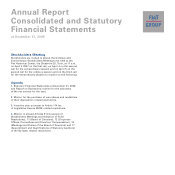Chrysler 2006 Annual Report Download - page 12
Download and view the complete annual report
Please find page 12 of the 2006 Chrysler annual report below. You can navigate through the pages in the report by either clicking on the pages listed below, or by using the keyword search tool below to find specific information within the annual report.
At December 31, 2006, the Group had 172,012 employees,
compared with 173,695 at December 31, 2005. During
the year around 18,600 new employees were hired, while
a total of around 19,300 employees left the Group. Changes
in the scope of consolidation of the Group entailed a net staff
decrease of approximately 1,000 employees, mainly as a result
of the sale by Teksid of the French company SBFM, the sale
of B.U.C. – Banca Unione di Credito and of Fiat Auto’s
financial services following the creation of the joint venture
FAFS with Crédit Agricole.
As regards recruitment, over 900 recent university graduates
were added to Group staff, mainly in engineering
departments. The Group’shigh skill staff (“professional”)
totalled approximately 25,000, 44% of whom work outside
Italy.
Evolution in the organisational
and managerial structure
In 2006, Fiat continued to strengthen its management
organisation. It continued to attract managers from outside
the Group to cover vacant positions. A total of 137 managers
were hired from outside the Group, five of whom were
selected to fill top positions at the Group’s Sectors. In the
meantime, focus on internal development of human resources
continued. This included mobility between the different
business sectors. Expanded use of leadership assessments
at the managerial as well as non-managerial level made
asignificant contribution to spread the model introduced
in 2004.
Accelerated growth of the most talented internal resources
was supported by directly involving the company’s top leaders
at talent management meetings. These gatherings serve
to identify individuals and define their development plans.
At the organisational level, 2006 brought confirmation of the
guidelines on which the new Fiat corporate culture is based.
They reflect two strategic approaches to the business:
on the one hand, the unity of the Group, and on the other
hand the specific characteristics of the operating sectors
in their respective businesses.
Report on Operations Research and Innovation20
Human Resources
Training
The Group invested approximately 95 million euros in training
programmes designed to support the operations of the Group
and the professional development of its employees.
Isvor Fiat provided training, consulting, and professional
support programs for a total of 18,505 classroom/training days.
An additional 24,685 users received a total of 118,699 hours
of Web-based distance learning support.
Grants and Scholarships
The Fiat Grants and Scholarships program, which was created
to help the children of active employees in Italy and in other
countries in which the Group has a significant presence, is
continuing with considerable success. This initiative was
extended to China in 2006.
In 2006, Fiat awarded 636 grants, 185 to students in Italy and
451 to students in other countries, at a total cost of 1,072,900
euros.
Industrial relations
In 2006 a constant dialogue was maintained with trade unions
and representatives of employees at the company level in
order to find consensus solutions to handle the consequences
on workers of measures taken to respond to market needs,
improve competitiveness, flexibility,and organisational
efficiency. Collective bargaining at the various levels was also
intense, allowing the trade unions to reach major agreements
defining pay conditions and rules in the various countries
where the Group operates.
Social dialogue
At the European level, issues concerning the condition of the
Fiat Group, especially those that have a transnational impact,
were subject of information and consultation with the
members of the Fiat Group European Works Council (EWC),
as required under EU Directive 45/94/EC.The Fiat Group EWC,
which represents the employees of Group companies located
in the European Union, was established in 1997 and is
comprised by 30 representatives of the various countries
in proportion to the current employment distribution of
the Fiat Group in Europe.
Report on Operations Human Resources 21
■Control software development. Elasis assisted CNH in
designing and developing the control unit for the Cobra
tractor’s continuously variable transmission, and worked
alongside Ferrari in designing and testing traction control
software and in designing a prototype vehicle ride height
control system. In addition, Elasis helped set up a dedicated
Hardware-In-the-Loop lab for testing electronic control units
of engines, and cooperated in testing electronic control units
of Formula 1 racers.
■New HIL Hardware-in-The-Loop simulation models. Elasis
adapted the hardware and software used in the HIL Virtual
Car simulator to two models now being developed by Fiat
Auto: the new Fiat 500 and the Minicargo. For Magneti Marelli
Electronic Systems, Elasis developed an HIL simulator to
validate body computer software.
■Fire engines. In 2006, Elasis continued its development and
product engineering work on Fire series engines. This work
focused on reducing consumption and toxic emissions to meet
Euro 5 limits, on increasing performance, on improving quality
and reliability,and on cutting costs. During the year,the Fire
1.4-litre 16-valve Starjet engine was put into production.
Installed on the Fiat Grande Punto, the new engine combines
excellent fuel economy with sparkling performance. Product
engineering work was also completed on the new 1.4-litre 16-
valve turbocharged unit that entered production in February
2007, and on the new naturally aspirated Fire 1.4-litre 16-valve
Multiair engine.
■Mobility and traffic safety.In this area, Elasis concentrated
its attention on efforts to increase its know-how,and on
participating in European Union and national projects. The
former included TRACE (Traffic Accident Causation in Europe)
a project which aims to identify the most common causes of
traffic accidents and assess the effectiveness of existing safety
systems. In Italy, Elasis embarked on partnerships with the
provincial administrations of Milan, Mantua and Macerata
and with the Municipality of Sorrento. These initiatives hope
to make streets and roads safer by auditing and analysing
traffic accidents.
























